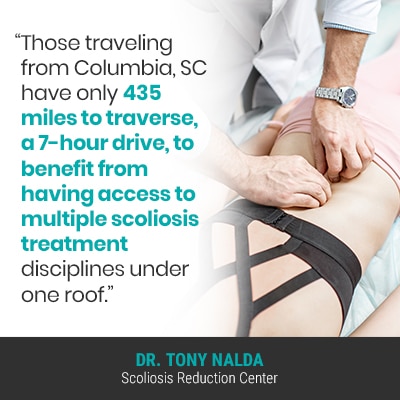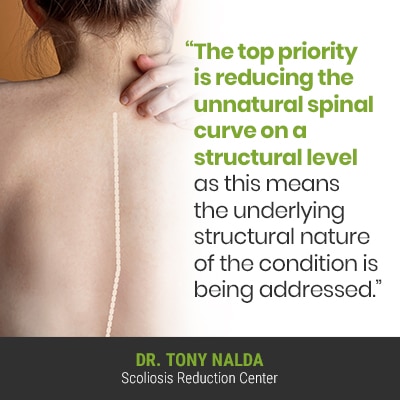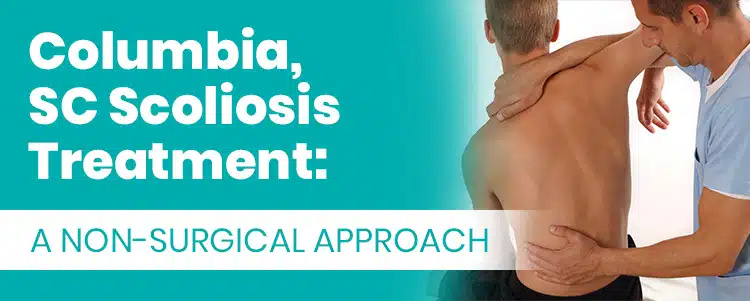When a person is diagnosed with scoliosis, the most important decision to be made is how best to treat it, and that’s because as a progressive condition, scoliosis can’t simply be cured, but it can be highly treatable. Continue reading to find out how different treatment approaches affect the spine differently.
When it comes to non-surgical scoliosis treatment, those in Columbus, SC need only a 7-hour car drive, or a 1.5-hour flight to put them within reach of Dr. Tony Nalda’s industry-leading Scoliosis Reduction Center®, where treatment results speak for themselves.
As a progressive condition, scoliosis is virtually guaranteed to get worse over time, and this is why how a condition is treated is so important.
Scoliosis is Progressive
As scoliosis involves the development of an unnatural sideways spinal curve that also rotates, the condition progressing means that size of the scoliotic curve is increasing.
As scoliosis progresses, the spine gets increasingly rigid, and this makes it less responsive to chiropractic treatment, and it can also affect a patient’s ability to perform certain therapeutic exercises that are key to treatment.
When a patient is diagnosed after significant progression has already occurred, which is common in adult patients, if the spine is excessively rigid, before starting the regular course of treatment, I first have to work on restoring a baseline level of spinal flexibility, and this just takes more time.
Scoliosis ranges widely in severity from mild to moderate and severe to very severe, and this is also the condition’s progressive line; while there are never treatment guarantees, scoliosis that’s diagnosed and treated early, while mild, does typically respond better.
Put simply, there are fewer limits to what I can achieve when scoliosis is detected and treated early in its progressive line.
So that brings us to treatment, and there are two main treatment responses to scoliosis: surgical or non-surgical.
Surgical Scoliosis Treatment
A surgical response to scoliosis would mean spinal fusion surgery, and while all surgeries come with their share of risks, spinal fusion is a particularly lengthy, costly, and invasive procedure that comes with some heavy potential risks, complications, and effects.
Spinal fusion involves fusing the most-tilted vertebrae, at the curve’s apex, into one solid bone, and this is done with the goal of stopping further progression; however, this is not the same as actually working towards correcting a scoliosis by reducing the curve, which we’ll return to shortly.
Spinal fusion also involves attaching rods to the spine with pedicle screws to hold it in place, and while the procedure can help straighten a bent spine, the traditional approach that recommends surgery does little beforehand to prevent progression.
The traditional approach doesn’t have a strategy for treating scoliosis while mild, so does little other than recommending that patients simply watch and wait, but as a progressive condition, we know it’s going to progress at some point, so why not be proactive and start treatment when it’s most likely to be effective?
Non-Surgical Scoliosis Treatment
A non-surgical modern conservative treatment approach is what patients of the Scoliosis Reduction Center® benefit from.

Those traveling from Columbia, SC have only 435 miles to traverse, a 7-hour drive, to benefit from having access to multiple scoliosis treatment disciplines under one roof.
Part of a conservative approach is integrating multiple different types of treatment so treatment plans can be fully customized and conditions can be impacted on every level.
I combine condition-specific chiropractic care, physical therapy, corrective bracing, and rehabilitation.
As a structural condition, scoliosis has to be impacted primarily on a structural level, and this is worked towards through a series of chiropractic techniques and manual adjustments that can reduce the curve by repositioning its most-tilted vertebrae back into alignment with the rest of the spine.
While the place of exercise in scoliosis treatment was once questioned, we now know that when physical therapy is scoliosis-specific and integrated into a proactive treatment plan, it can help by increasing core strength; this means the spine’s surrounding muscles can provide it with optimal support.
In addition, physical therapy can help improve posture and certain scoliosis-specific exercises can activate specific areas of the brain for improved brain-body communication.
As scoliosis introduces a lot of uneven forces to the body, it not only disrupts posture, but can also cause a muscle imbalance to develop, and physical therapy can also address this by stretching and relaxing the overused muscles on one side of the spine, and tightening and strengthening the underused muscles on the opposite side.
Corrective bracing can be particularly effective on growing spines and can complement other treatment disciplines by pushing the spine into a corrective position.
The final phase of treatment is one that is ongoing, and this involves a series of custom-prescribed home exercises so patients can establish a home-rehabilitation program to sustain treatment results and further stabilize the spine.

The top priority is reducing the unnatural spinal curve on a structural level as this means the underlying structural nature of the condition is being addressed.
Conclusion
For residents of Columbia, SC who are wondering if a 7-hour drive to Celeration, Florida is worth it, consider the benefits of a less-invasive non-surgical scoliosis treatment method that preserves as much of the spine’s natural strength and function as possible.
As Florida is also home to Disney World, Universal Studios, beautiful beaches and more, there are a number of reasons, in addition to the main motivating factor of accessing Dr. Tony’s standard-setting non-surgical scoliosis treatment.
While spinal fusion can straighten a scoliotic spine, the way it does so is contrary to the spine’s movement-based design; many patients are disappointed by the lack of spinal flexibility and range of motion they are left with.
A spine that doesn’t function as well is going to be weaker, more vulnerable to injury, and can lead to activity restrictions that can impact overall quality of life.
So don’t hesitate to reach out to the Scoliosis Reduction Center®, where Dr. Tony has been reducing unnatural spinal curves, with impressive results, for over 20 years.




